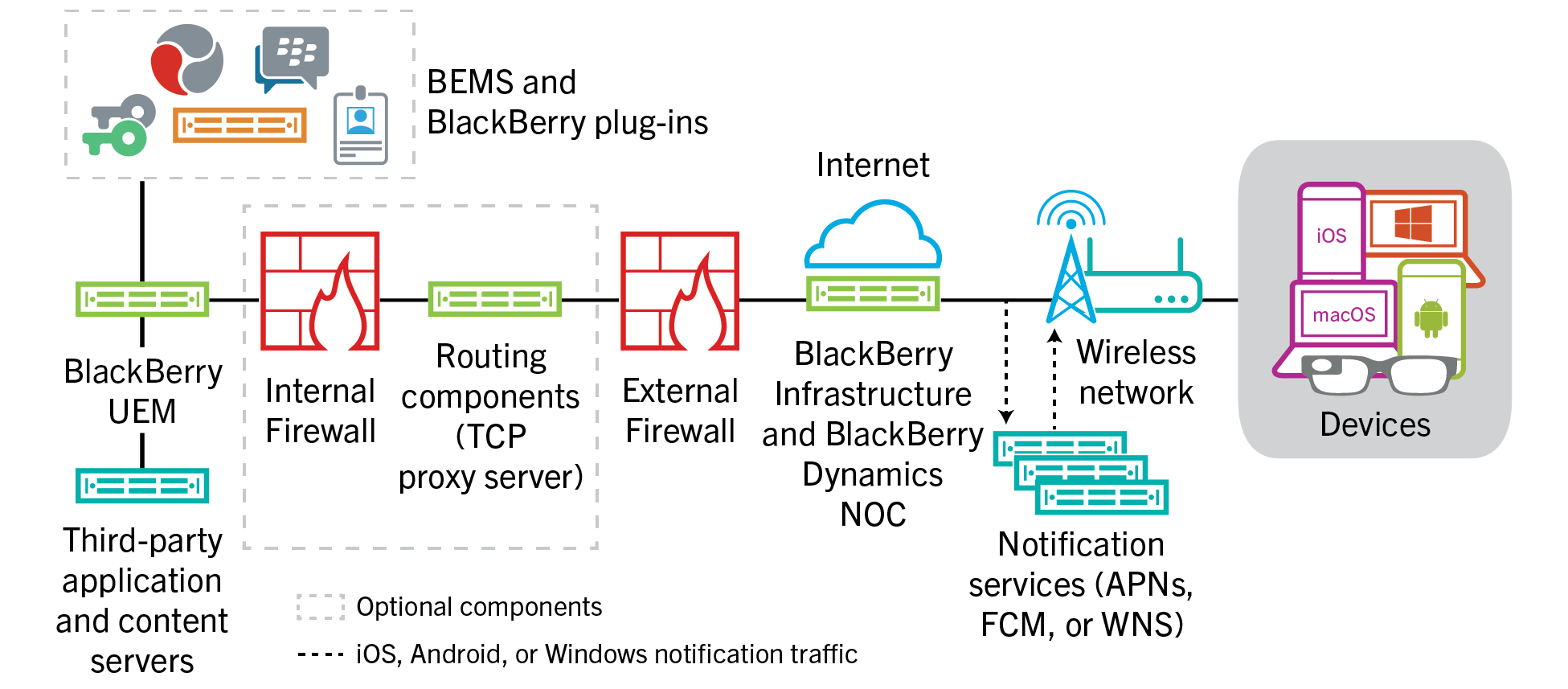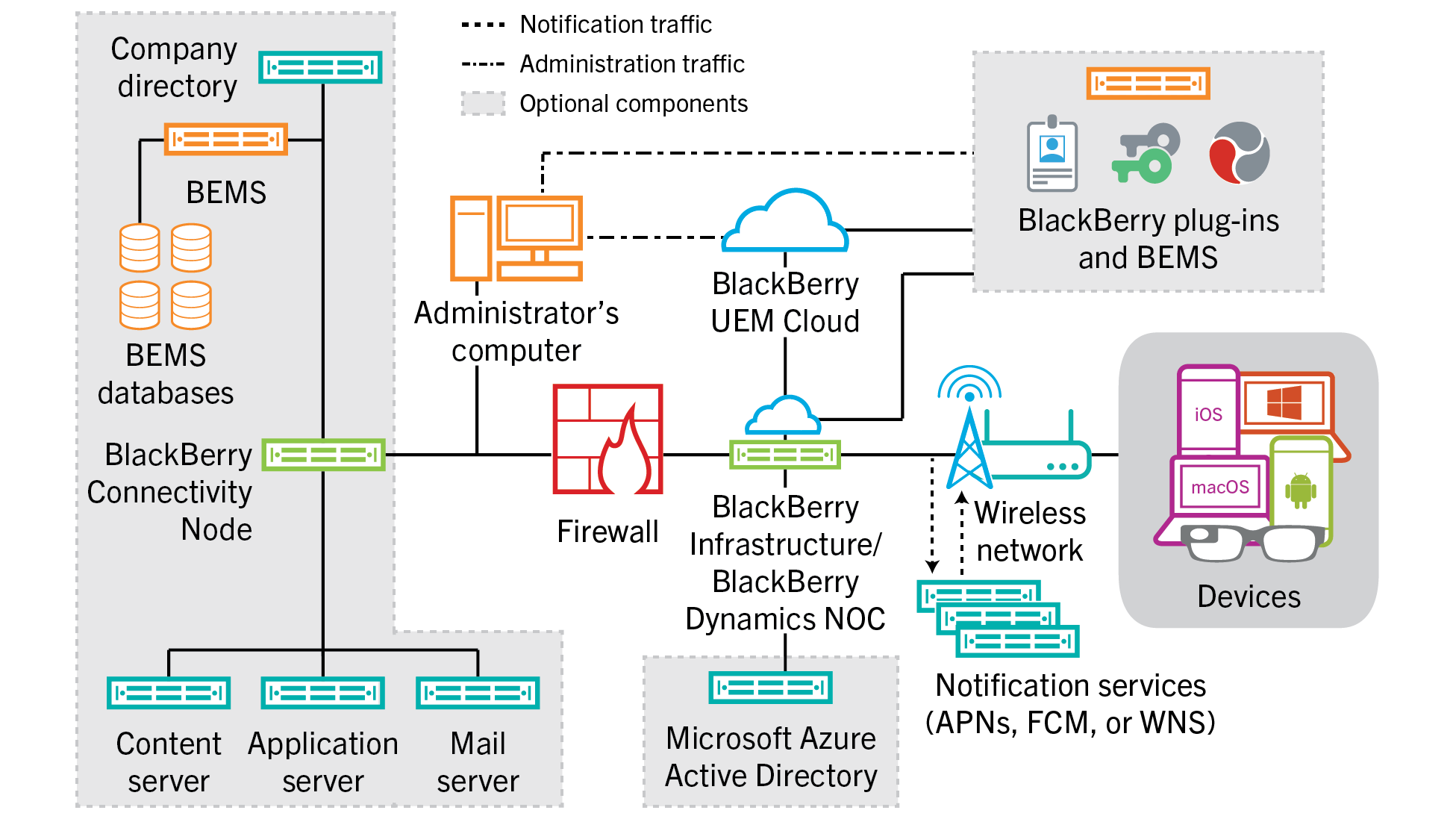BlackBerry UEM architecture
BlackBerry UEM
architectureThe
BlackBerry UEM
architecture is designed to help you manage mobile devices for your organization and provide a secure link for data to travel between your organization's mail and content servers and your user's devices.Architecture: BlackBerry UEM solution
BlackBerry UEM
solution
Component | Description |
|---|---|
BlackBerry UEM | BlackBerry UEM is a unified endpoint management solution that provides comprehensive multiplatform device, application, and content management with integrated security and connectivity. |
BlackBerry Infrastructure | The BlackBerry Infrastructure is a global private data network distributed across multiple regions that enables and secures data in transit between thousands of organizations and millions of users around the world. It is designed to efficiently manage the transport of data between BlackBerry services and end-user devices.For organizations using UEM , the BlackBerry Infrastructure registers user information for device activation, validates licensing information, and provides a trusted path between the organization and every user based on strong cryptographic mutual authentication. UEM maintains a constant connection to the BlackBerry Infrastructure , ensuring that organizations require only a single outbound connection to a trusted IP address to send data to users. All the data that travels between the BlackBerry Infrastructure and UEM is authenticated and encrypted to provide a secure communication channel into your organization for devices outside the firewall. |
BlackBerry
Dynamics NOC | The BlackBerry
Dynamics NOC is a network operations center that provides secure communications between BlackBerry
Dynamics apps on devices, UEM , and the BlackBerry Enterprise Mobility Server . |
Devices | BlackBerry UEM supports iOS , macOS , Android , and Windows devices. |
Notification services | UEM sends notifications to devices to contact UEM for updates and to report information for your organization’s device inventory. These notifications are sent to the BlackBerry Infrastructure , where they are sent to the devices using the appropriate notification service:
|
Routing components | By default, UEM makes a direct connection to the BlackBerry Infrastructure over ports 3101 and 443, and you do not need to install more routing components. If your organization's security standards require that internal systems cannot make connections directly to the Internet, you can use the BlackBerry Router or a proxy server.The BlackBerry Router acts as a proxy server for connections over the BlackBerry Infrastructure between UEM and all devices. The BlackBerry Router can support SOCKs v5 with no authentication.If your organization already has a TCP proxy server installed, or needs one to meet networking requirements, you can use a TCP proxy server instead of the BlackBerry Router . The TCP proxy server can support SOCKs v5 with no authentication.The BlackBerry UEM Core and BlackBerry Proxy support using an HTTP proxy server to connect to the BlackBerry
Dynamics NOC. |
Third-party application and content servers | Additional content servers and application servers in your organization's environment, including the company directory, mail server, certificate authorities, and so on. |
BlackBerry plug-ins and BEMS | UEM works with additional BlackBerry enterprise products such as BlackBerry Enterprise Identity , BlackBerry 2FA , and BlackBerry Workspaces to extend UEM capabilities in your organization. For more information, see Companion products and services.The BlackBerry Enterprise Mobility Server provides services to send work data to and from BlackBerry
Dynamics apps. For more information, see the BlackBerry Enterprise Mobility Server docs. |
Architecture: BlackBerry UEM Cloud solution
BlackBerry UEM Cloud
solutionThe
BlackBerry UEM Cloud
architecture was designed to help you manage mobile devices for your organization in a cloud environment and provide a secure link for data to travel between your organization's mail and content servers and your users' devices.
Component | Description |
|---|---|
BlackBerry UEM Cloud | BlackBerry UEM Cloud is a service that allows you to manage devices used in your organization's environment. |
BlackBerry Infrastructure and BlackBerry Dynamics NOC | The BlackBerry Infrastructure registers user information for device activation and validates licensing information. If you enable BlackBerry Secure Connect Plus or the BlackBerry Secure Gateway , data in transit that uses these services passes through the BlackBerry Infrastructure .The BlackBerry Dynamics NOC is a separately located NOC that provides secure communications between BlackBerry
Dynamics apps on devices and BlackBerry Proxy installed behind the firewall as part of the BlackBerry Connectivity Node . |
Devices | BlackBerry UEM Cloud supports iOS , macOS , Android , and Windows devices. |
Notification services | UEM Cloud sends notifications to devices to contact UEM for updates and to report information for your organization's device inventory. These notifications are sent to the BlackBerry Infrastructure , where they are sent to devices using the appropriate notification service:
|
BlackBerry Connectivity Node | The BlackBerry Connectivity Node is an optional component that you install inside your organization's firewall. It includes the following components that add functionality to UEM Cloud :
|
Company directory | UEM Cloud supports connectivity with your organization's Microsoft Active
Directory or LDAP company directory behind the firewall using the BlackBerry Connectivity Node . |
Microsoft Entra ID (formerly Azure AD) | Microsoft Entra ID is a cloud-based directory management service. If your organization uses Entra ID , you can connect to it instead of, or in addition to, a company directory behind the firewall. |
Content, application, and mail servers | When you enable BlackBerry Secure Connect Plus or when users have BlackBerry
Dynamics apps, devices can connect to your organization's servers without requiring you to open a direct connection between the server and the Internet. Work data in transit between your servers and devices is sent through BlackBerry Secure Connect Plus and the BlackBerry Infrastructure . BlackBerry
Dynamics app data is sent through BlackBerry Proxy and the BlackBerry Dynamics NOC .BlackBerry Secure Gateway provides a secure connection through the BlackBerry Infrastructure and BlackBerry Connectivity Node between your organization's mail server and iOS devices. |
BlackBerry plug-ins and BEMS | UEM works with additional BlackBerry enterprise products such as BlackBerry Enterprise Identity , BlackBerry 2FA , and BlackBerry Workspaces to extend UEM capabilities in your organization. For more information, see Companion products and services.The BlackBerry Enterprise Mobility Server provides services to send work data to and from BlackBerry
Dynamics apps. For more information, see the BlackBerry Enterprise Mobility Server docs. |